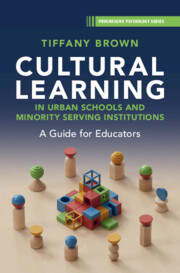Book contents
- Cultural Learning in Urban Schools and Minority Serving Institutions
- The Progressive Psychology Book Series
- Cultural Learning in Urban Schools and Minority Serving Institutions
- Copyright page
- Contents
- Figures and Tables
- Introduction
- Chapter 1 An Action Science Approach to Cultural Learning in Urban Schools and Minority Serving Institutions (MSIs)
- Chapter 2 Directly Observable Data on K-12 Teachers in Urban Schools
- Chapter 3 Culturally Accepted Meanings and Understandings Shared by K-12 Urban Teachers
- Chapter 4 Individual Action Strategies K-12 Urban Teachers Use at Work
- Chapter 5 Collective Action Strategies K-12 Urban Teachers Use at Work
- Chapter 6 Single-Loop Learning and Double-Loop Learning Conditions in Urban Schools
- Chapter 7 Implications from the Systematic Review for Four Types of Cultural Learning K-12 Urban Teachers Engage in at Work
- Chapter 8 Empirical Research on College Faculty Thinking and Action in a Minority Serving Institution
- Chapter 9 Faculty Value Orientations for Single-Loop Learning and Double-Loop Learning at Work with Students from LIMCCs
- Chapter 10 Consequences of Model I and Model II Values for Learning across Student–Teacher Cultural Differences in MSIs
- Chapter 11 Faculty Variance in Use of Traditional and Culturally Responsive Classroom Management Strategies
- Chapter 12 Consequences of Variance in Use of Traditional and Culturally Responsive Classroom Management Strategies for Learning across Student–Teacher Differences in MSIs
- Chapter 13 Implications from the Empirical Data for Instructor Learning across Cultures in MSIs
- Conclusion
- Appendices
- References
- Subject Index
- References
- Cultural Learning in Urban Schools and Minority Serving Institutions
- The Progressive Psychology Book Series
- Cultural Learning in Urban Schools and Minority Serving Institutions
- Copyright page
- Contents
- Figures and Tables
- Introduction
- Chapter 1 An Action Science Approach to Cultural Learning in Urban Schools and Minority Serving Institutions (MSIs)
- Chapter 2 Directly Observable Data on K-12 Teachers in Urban Schools
- Chapter 3 Culturally Accepted Meanings and Understandings Shared by K-12 Urban Teachers
- Chapter 4 Individual Action Strategies K-12 Urban Teachers Use at Work
- Chapter 5 Collective Action Strategies K-12 Urban Teachers Use at Work
- Chapter 6 Single-Loop Learning and Double-Loop Learning Conditions in Urban Schools
- Chapter 7 Implications from the Systematic Review for Four Types of Cultural Learning K-12 Urban Teachers Engage in at Work
- Chapter 8 Empirical Research on College Faculty Thinking and Action in a Minority Serving Institution
- Chapter 9 Faculty Value Orientations for Single-Loop Learning and Double-Loop Learning at Work with Students from LIMCCs
- Chapter 10 Consequences of Model I and Model II Values for Learning across Student–Teacher Cultural Differences in MSIs
- Chapter 11 Faculty Variance in Use of Traditional and Culturally Responsive Classroom Management Strategies
- Chapter 12 Consequences of Variance in Use of Traditional and Culturally Responsive Classroom Management Strategies for Learning across Student–Teacher Differences in MSIs
- Chapter 13 Implications from the Empirical Data for Instructor Learning across Cultures in MSIs
- Conclusion
- Appendices
- References
- Subject Index
- References
- Type
- Chapter
- Information
- Cultural Learning in Urban Schools and Minority Serving InstitutionsA Guide for Educators, pp. 223 - 265Publisher: Cambridge University PressPrint publication year: 2025

